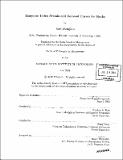| dc.contributor.advisor | Stephen A. Ross and Jiang Wang. | en_US |
| dc.contributor.author | Petäjistö, Antti, 1974- | en_US |
| dc.contributor.other | Sloan School of Management. | en_US |
| dc.date.accessioned | 2005-06-02T16:21:05Z | |
| dc.date.available | 2005-06-02T16:21:05Z | |
| dc.date.copyright | 2003 | en_US |
| dc.date.issued | 2003 | en_US |
| dc.identifier.uri | http://hdl.handle.net/1721.1/17601 | |
| dc.description | Thesis (Ph. D.)--Massachusetts Institute of Technology, Sloan School of Management, 2003. | en_US |
| dc.description | Includes bibliographical references (p. 140-141). | en_US |
| dc.description.abstract | This thesis consists of three chapters that investigate the index premium and its underlying economics both theoretically and empirically. The first chapter presents our empirical findings about the index premium and its properties. First, we find that the index premia for both the S&P 500 and Russell 2000 have been growing over time, reaching levels of about 15% and 10%, respectively, in 2000. The premia arise somewhat gradually between the announcement and effective days and do not reverse at least in the next few weeks. Second, we find that the index premium is related to the idiosyncratic risk and market equity of a firm with economic and statistical significance. Third, we introduce a new concept that we label the index turnover cost, which represents a cost borne by index funds due to the index premium. We illustrate this cost and estimate it as 70-85 bp annually for the S&P 500 and 110-211 bp annually for the Russell 2000. The second chapter develops the first theoretical explanation in the literature for downward-sloping demand curves. In traditional multi-asset models such as the CAPM, demand curves for stocks are almost perfectly horizontal, because a representative investor who is sufficiently risk-tolerant to hold the entire market portfolio has to be almost indifferent to idiosyncratic risk. We start with the basic CAPM setting, but we further assume that there is a fixed cost to actively managing a stock portfolio and that individuals pay the cost through an institution as a proportional fee. In equilibrium, the proportional fee can entirely determine the cross-sectional pricing of stocks, while the risk aversion of individual investors still determines the aggregate market risk premium. | en_US |
| dc.description.abstract | (cont.) In contrast to any representative agent models, this allows demand curves for stocks to be sufficiently steep to have economic significance, also implying that stocks will be priced only approximately around their fundamental values. Our explanation can account for several empirically observed puzzles such as the magnitude of the S&P 500 index premium. The third chapter focuses on index investors for whom the index premium creates a recurring cost: as the index is updated, they need to buy stocks with the premium and sell stocks without the premium. Different index rules can produce different index premia due to the different frequency and criteria of updating. We build a model to investigate the behavior of the index turnover cost and the portfolio performance of a mechanical index fund under a market-cap rule, an exogenous random rule, and a deterministic rule. We find that the rational anticipation of future index composition reflected in prices today eliminates any first-order differences in index fund performance across the three index rules. As the index investors become a large part of the market, the non-index investors become less diversified, and this induces hedging motives which hurt the index investors especially under a market-cap rule. | en_US |
| dc.description.statementofresponsibility | by Antti Petäjistö. | en_US |
| dc.format.extent | 159 p. | en_US |
| dc.format.extent | 6402206 bytes | |
| dc.format.extent | 6402015 bytes | |
| dc.format.mimetype | application/pdf | |
| dc.format.mimetype | application/pdf | |
| dc.language.iso | eng | en_US |
| dc.publisher | Massachusetts Institute of Technology | en_US |
| dc.rights | M.I.T. theses are protected by copyright. They may be viewed from this source for any purpose, but reproduction or distribution in any format is prohibited without written permission. See provided URL for inquiries about permission. | en_US |
| dc.rights.uri | http://dspace.mit.edu/handle/1721.1/7582 | |
| dc.subject | Sloan School of Management. | en_US |
| dc.title | Essays on index premia and demand curves for stocks | en_US |
| dc.type | Thesis | en_US |
| dc.description.degree | Ph.D. | en_US |
| dc.contributor.department | Sloan School of Management | |
| dc.identifier.oclc | 53483999 | en_US |
